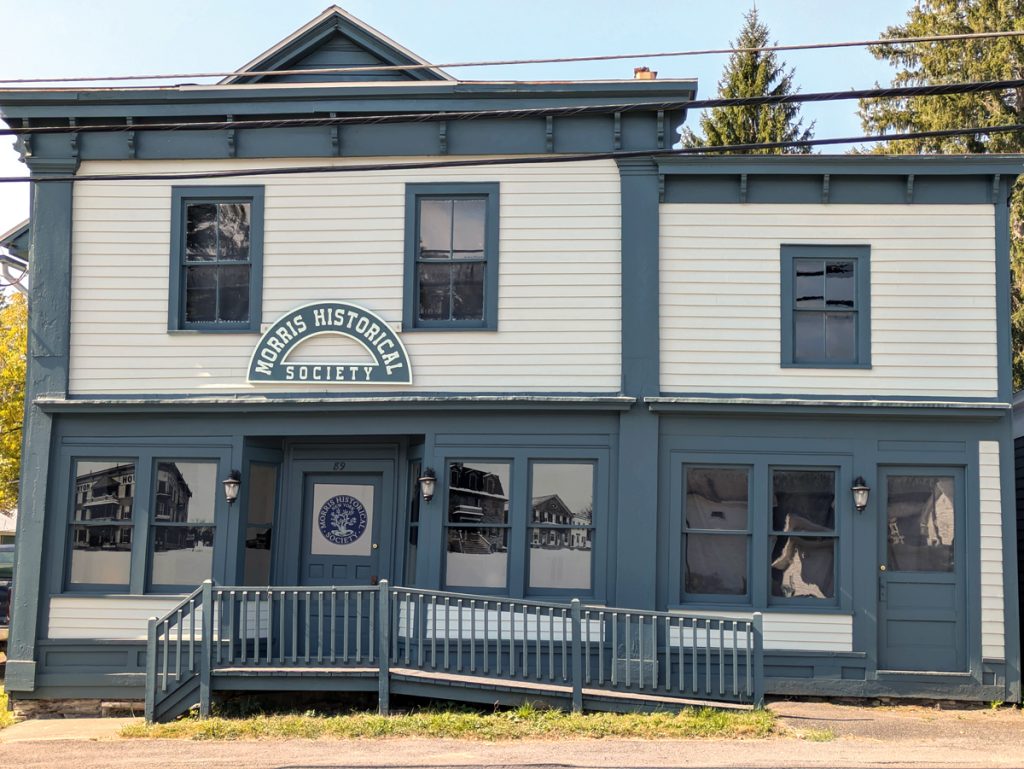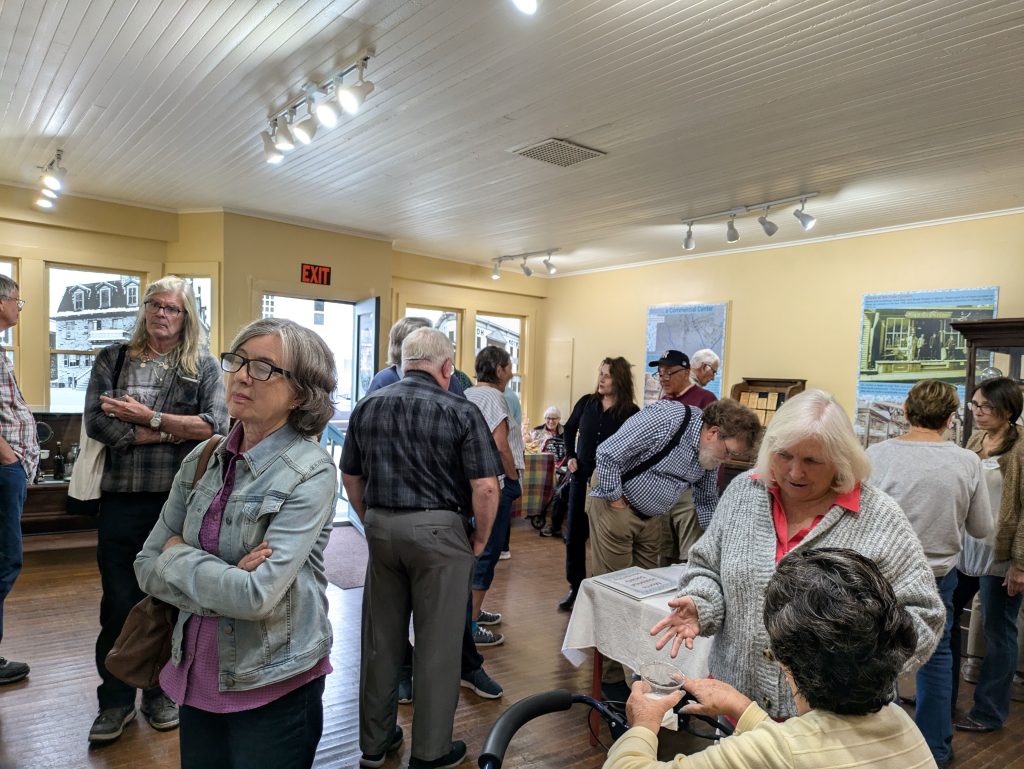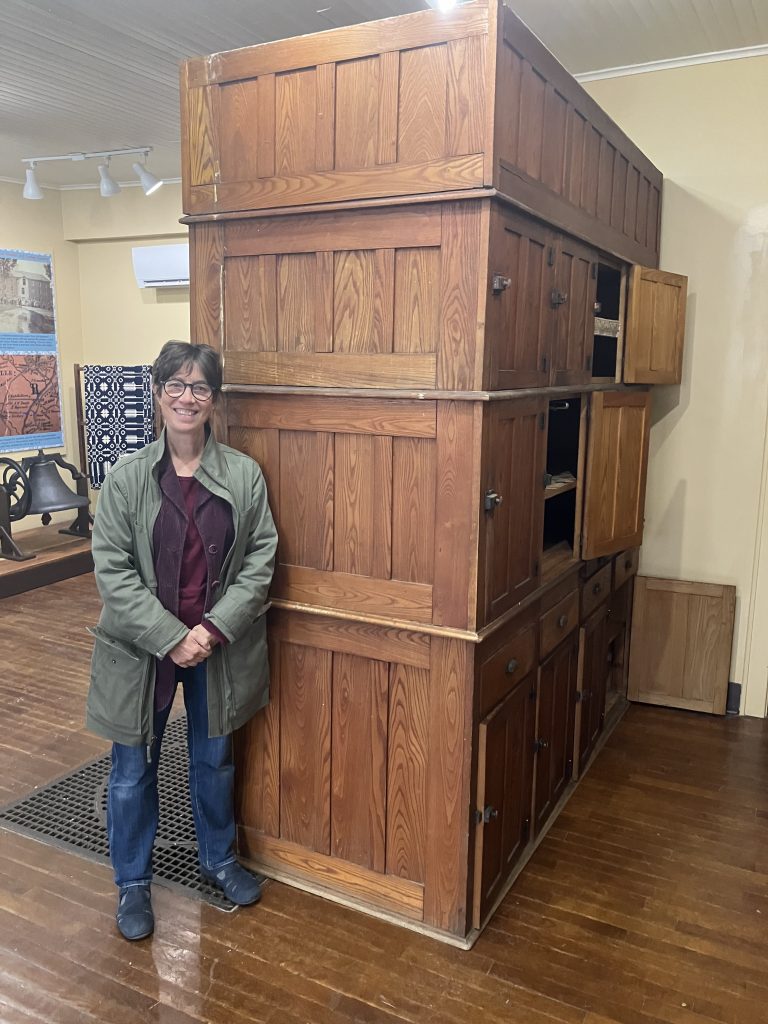
New Museum Brings To Life Morris of Bygone Days
By TERESA WINCHESTER
MORRIS
Since its opening in September 2023, the Gatehouse Coffee Shop at the corner of Main and Broad streets in the Village of Morris has injected a welcomed vitality into the village. But imagine a time when 32 stores operated simultaneously on these two principal streets in Morris. Such was the case, as related in the 1872-73 edition of the “Business Directory of Otsego County.”
The newly-opened Morris Historical Society Museum has done a commendable job in documenting the once thriving community.
On Sunday, September 29, MHS welcomed approximately 125 visitors to the museum at 89 Broad Street. The open house included tours of the renovated spaces of the structure, donated in 2022 to MHS by American Legion Post #1135.

“My sister (Janet Washbon) and I are happy to see the historical society realize their goal of opening the museum and re-purposing the historic structure. We are thrilled we could contribute research and resources to this endeavor and how well curated and informative the exhibits are,” said Tom Washbon, whose family lines in Morris reach as far back as the 1790s.
“The best part of the opening was the smile on the faces of the people coming into the room,” said MHS board member and Village of Morris historian Bob Thomas.
Built between 1800 and 1820, the museum building is the oldest surviving commercial building in the village and originally housed E.C. Williams Dry Goods and Grocery. It was moved from the corner of Main and Broad streets between 1835 and 1838 and, until 1954, functioned variously as tin, stove, hardware, and grocery stores, restaurants, an oyster and billiard saloon, a hoop skirt factory, and a barber shop.
The structure, featuring a false Italianate front added sometime between 1860 and 1910, is predominantly white with grayish-blue trim. The windows feature a blown-up photograph of a snow-covered Morris taken by the early 20th century photographer Norm Carey.
“The thing the people like the most about the museum is the windows. If lights are left on at night, it makes for a beautiful display,” said Stacia Gregory Norman, secretary and treasurer of MHS, who, with her husband Gary Norman (MHS president) and other MHS board members, has been a principal developer of the museum. Besides Stacia, Gary and Bob Thomas, MHS board members include Eileen Elliott, Rene Elliott, and Diana Birdsall.
The museum features four large posters presenting Morris (until 1870 known as Louisville) as a commercial center, documenting various stores, the Benjamin Chair Factory, and the Butternut Woolen and Cotton Factory.
Situated at the intersection of state routes 23 and 51, commonly referred to as “the four corners,” Morris has always been a major crossroads, according to Gary, who also noted that today’s traffic includes Amish buggies as well as 18-wheelers.
“The intersection of roads and creeks encouraged commerce. The creeks allowed industry to thrive and the roads allowed transportation of goods, producers, and consumers,” Gary said.
The Butternut, Calhoun and Silver creeks provided the water power to enable “textile, grist and saw mills, as well as tanneries and furniture factories,” as noted in one poster.
The Butternut Road (now State Route 51), the Charlotte Turnpike (now State Route 23) and the Sherburne Turnpike (now County Route 13) converged at the four corners to bring business and industry to the village.
Between 1897 and 1907, V.L. Curtis, dealing in coal, flour, and grain, operated on South Broad—site of a parking lot that formerly served Community Bank. In September 1904, the “Morris Chronicle,” published weekly from the 1860s until 1963, wrote, “The local feed store at Morris handles not less than 300 tons of feed a year, and its trade is practically a local retail business.”
Another major commercial enterprise was Charles H. Lawrence Hardware, operating from 1914 to 1930 on West Main St.—site of the current H.W. Naylor Company, a leading manufacturer of animal health products. The museum contains an original display case from the hardware store.
Two factories—the Benjamin Chair Factory (1856-1942) and the Butternuts Woolen and Cotton Mill (1825-1885) also drove the Morris economy. Of the chair factory, located in the hamlet of Elm Grove on the current County Route 49, the “Morris Chronicle” wrote, “Mr. George Benjamin’s chair factory…has the reputation of building the best chairs of any establishment in the country.” Two side chairs, a rocking chair and a double-sided, built-in cupboard from the chair factory may be seen at the museum. The cupboard is of particular interest, with drawers and cabinets on either side, enabling it to open into both kitchen and dining room.
The woolen and cotton mill was one of two Morris textile mills powered by water from the Butternut Creek. Its four-story stone building was located on East Side Road, in the general vicinity of today’s Weaver’s Farm Market, an Amish-owned grocery store. Employing some 80 men, women, and children, it produced cotton thread, cloth, and batting. The mill constituted a virtual village, occupying 40 acres, with 10 houses for employees and one for the mill superintendent. Children attended an on-site school until they began working at the mill, between ages 10-12.

Museum artifacts include, among many other things, a locally-made skirt hoop, a masonic chair, issues of the “Morris Chronicle,” and clothing from the Bridges family, including several children’s sailor suits.
“The clothing collection came from a house on West Street, in which four generations of Shanessy/Bridges had lived. Maurice Shanessy emigrated from Ireland in 1852 and was a peddler. The clothing belonged to his daughter and grandchildren,” Stacia wrote in an e-mail communication.
Many documents from former Morris businesses are also in the museum’s collection and available for research: documents from Linn Manufacturing, which, from 1916 to 1952, made Caterpillar half-track tractors used for off-road freight hauling and for rural snow plowing, from Gould and Bridges Insurance, and from hotels and photographers.
“There were lots of photographers, so we have lots of photos,” Stacia said, adding that the collection features “lots of artists, too”—one of whom was the prolific artist Florence Monroe Davis (1894-1969). Both tin and wood objects painted by Davis will be on future display.
The museum may be newly opened but, Gary said, “We are already outgrowing our space.” Up next for MHS is the renovation of the 1860s addition to 89 Broad, which will double both exhibition and storage spaces.
Museum hours are on Saturdays from 10 a.m. to 2 p.m. through November 30.
Tax-deductible donations to support continuing work on the museum may be sent to Morris Historical Society, PO Box 332, Morris, NY 13808.

